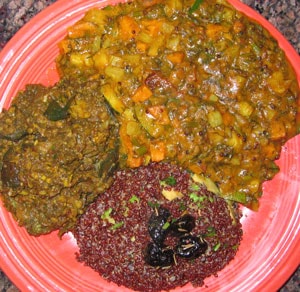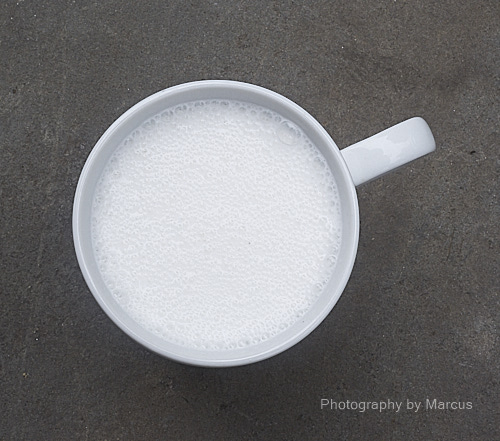Yogurt and Cheese
Overview
Fresh yogurt is nutritious and healthful if used appropriately. It helps to maintain the balance of intestinal flora and promotes good digestion. Commercial yogurt is not generally optimal because it tends to be old and sour. Fortunately, yogurt very easy and inexpensive to make.
Yogurt is best consumed during the middle of the day when digestion is strongest, or during the afternoon. It should not be taken full strength or cold. It should be avoided in the evening. While it combines well with a wide variety of foods and can be used in sauces, it is not compatible with banana.
When diluted with water, yogurt makes a delicious beverage known as lassi (see below). Lassi is tri-doshic (balancing for Vata, Pitta and Kapha).
In general, all curds (yogurt, cheese, sour cream, tofu, etc.) should be avoided in the evening. Such foods are considered heavy and hard to digest. They are likely to produce Ama and contribute to various diseases when taken in the evening when the digestive fire is weaker. Aged and mold-ripened cheeses are not Sattvic and are potentially damaging to health. Fresh, sweet-tasting cheeses (mozzarella, cottage cheese, panir, etc.) are both Sattivc and balancing for Vata. They are generally OK for Pitta, but are better avoided if there is significant Pitta imbalance. Cheese is most beneficial during Vata season. Cheese is not recommended for Kapha and is less healthful during Kapha season (Spring).
How to Make Yogurt
All you need to make yogurt is some good commercial yogurt for a "starter", fresh milk, and some clean wide mouth jars or drinking glasses. You'll also need a suitable incubator to hold the mixture of boiled milk and starter yogurt overnight at about 100°. Don't waste your money on a dedicated yogurt maker. I've had good results using an Instant Pot Duo mini. It also works well for pressure-cooking grains and legumes. I use default setting 8 hours on medium.
But you don't have to spend money to begin. For many years, I just used my oven with the inside light on. A 20 watt incandescent bulb puts out the right amount of heat. More than 40 watts and it'll get too hot. You could temporarily adjust for this by venting the door a little with a dish towel, even if it's not the energy efficient solution. If your oven doesn't have an inside light or if it is an LED, you can use a shop light with an old incandescent bulb plugged into a nearby outlet. You could also rig up a water bath with a small aquarium heater or a sous vide immersion heater that has a wide enough temperature range.
I've found that both Stonyfield Farms Organic plain lowfat and Greek-style yogurts give good results. I've even used their vanilla yogurt as a starter when the plain versions weren't available. If you can't find time to make your own, Stonyfield Farms would be a reasonable substitute. Of the many other yogurt starters I tested (including Dannon, Chopani, and Simple Truth) only Fayeh, Whole Foods, Organic Valley, Maple Hill Farm (NJ), Carolina Farmhouse Dairy, Green Valley Organics, Liberté and Yoplait Oui gave acceptable results. Yogurt is a living system. You will likely find that results may vary from batch to batch of starter. If you do your own tests, please let me know what happens.
In the evening, boil the quantity of milk needed to make the amount of yogurt that you expect to consume the following 1-2 days. A cup of milk will make about a cup of yogurt. You can add some chopped fresh ginger to the milk.
Let the milk cool in the pot until it is lukewarm. Put a Tablespoon or so of yogurt starter into a clean glass jar for every cup of milk. The exact proportion is not critical. Stir it up a bit and gradually add the milk. Screw the top on the jar and put it in your incubator overnight. In the morning, take it out and put it in the refrigerator until you're ready to use it. At that time, spoon out enough yogurt to serve as starter for your next batch into another clean jar and refrigerate. If you don't have suitable glass jars, just use drinking glasses and cover with plastic wrap.
That's all there is to it. Substitute heavy cream, light cream, or even half and half to make sour cream. I've maintained my own strain of yogurt this way for over a year at a time. If you screw up, leave town for an extended period, or it gets too sour, it's easy to start over.
Sweet Lassi
- Dilute a part fresh yogurt with 3-4 parts water in a blender
- Add whole cane sugar to taste: 1-3 tsp. per serving
- Add ground cardamom and rose water
- Blend briefly at low speed
- Skim off the butterfat foam, if any, before drinking
- You can also get acceptable results with less cleanup by stirring the ingredients in your intended drinking glass
Heavy pesticide and fungicide use is common with conventionally grown roses. Be safe. Get certified organic rose water, e.g., Alteya Organics or MAPI.
Salty Lassi
aka Ayurvedic Buttermilk, Digestive Lassi, Takra
- Dilute one part fresh fat-free yogurt with 3-6 parts water
- Add a pinch of pink mineral salt or black salt
- Add ground cumin, a bit of black pepper and optionally some ground ginger and/or coriander along with a leaf of fresh cilantro
The weaker the digestion, the more dilute should be the lassi. True Ayurvedic buttermilk (Takra) is made from the fluid remaining after churning cultured butter. It is said to be the best for correcting weak digestion and related disorders. In most countries, it would be difficult to find. Dilute lassi made with yogurt makes a good substitute.
If you don't have fat-free yogurt on hand, blend at speed for about 30 seconds and skim off the foam (visible in the photograph above) before drinking.
Black salt (Kala Namak) has a sulfurous odor that initially puts some people off, but it is easy to acquire a taste for it. The Vaidya's also recommend natural rock salt. It comes from ancient seabeds including the Himalayan mountains and has a pinkish color. Real Salt is a readily available brand.
For the best taste, dry pan roast cumin seeds until they give off their aroma and just start to brown. Grind what you need in a mortar and pestle. Store the rest in a small jar.
Mango Lassi
Mango lassi is just sweet lassi made with one part mango puree, one part yogurt and 1-2 parts water. Use either fresh mango or soak some dried organic mango pieces overnight in water. Puree the mango together with the desired amount of water, sugar, cardamom and rose water. Then add the yogurt and blend a little more.
Peppermint Lassi
This is said to be especially good for the male urinary system. It is made like salty lassi, but instead of water use freshly brewed peppermint tea (cooled) and omit the cilantro leaf.

Red quinoa with cilantro-avocado-olive garnish, baby eggplant in tamarind-coconut sauce, fennel, sweet potato and zucchini in yogurt sauce
Yogurt Sauce
Yogurt can be used to make a rich sauce for cooking vegetables. If you add it straight while cooking, it will usually curdle. The secret is to blend it with some flour from grain or legumes (wheat, rice, quinoa, chickpeas, mung beans, etc.) beforehand. Mix 1-2 Tablespoons of yogurt into 1 Tablespoon of flour and dilute with about 1 cup of water before adding to your saucepan. If you use chickpea (Besan) flour, it must cook for at least 20 minutes. Mung bean flour cooks more quickly and is tri-doshic.
Alternatively you can add yogurt to a dish at the very end to make it creamier. This works well with grains or kichari.
Fresh Cheese (Panir)
Fresh cheese is also simple to make at home. Stir 1.5 cups of milk into 3 Tablespoons of fresh yogurt, bring to a boil, and simmer 5-10 minutes. If the liquid whey hasn't turned fairly clear, add a bit more yogurt. Turn off the heat and let it stand for another 5-10 minutes. Strain off the whey and it's ready to use.
You can also use citric acid (sour salt) or lemon juice to curdle the milk instead of yogurt or as an adjunct to clarify the whey.
For a firmer cheese that can be cut into cubes or sautéed in oil or ghee, it needs to drain longer preferably with some weight on top.
Save the whey for cooking vegetables or as a soup base. Beware that most grains and lentils/beans don't soften properly when cooked in undiluted whey. This is not a problem with bulgur wheat.
